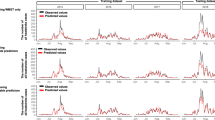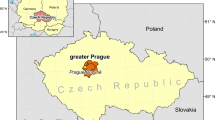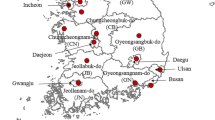Abstract
Extreme heat events have significant health impacts that need to be adequately quantified in the context of climate change. Traditionally, heat-health association methods have relied on statistical models using a single air temperature index, without considering other heat-related variables that may influence the relationship and their potentially complex interactions. This study aims to introduce and compare different machine learning (ML) models, which naturally consider interactions between predictors and non-linearities, to re-examine the importance of temperature, weather and air pollution predictors in modeling the heat-mortality relationship. ML approaches based on tree ensembles and neural networks, as well as non-linear statistical models, were used to model the heat-mortality relationship in the two most populated metropolitan areas of the province of Quebec, Canada. The models were calibrated using a comprehensive database of heat-related predictors including various lagged temperature indices, temperature variations, meteorological and air pollution variables. Performance was evaluated based on out-of-sample summer mortality predictions. For the two studied regions, models relying only on lagged temperature indices performed better, or equally well, than models considering more heat-related predictors such as temperature variations, weather and air pollution variables. The temperature index with the best performance differed by region, but both mean temperature and humidex were among the best indices. In terms of modeling approaches, non-linear statistical models were as competent as more advanced ML models for predicting out-of-sample summer mortality. This research validated the current use of non-linear statistical models with the appropriate lagged temperature index to model the heat-mortality relationship. Although ML models have not improved the performance of all-cause mortality modeling, these approaches should continue to be explored, particularly for other health effects that may be more directly linked to heat exposure and, in the future, when more data become available.




Similar content being viewed by others
Data Availability
The authors do not have permission to share health data. Weather and air pollution data are freely available from Environment and Climate Change Canada (ECCC).
References
Analitis A, De’Donato F, Scortichini M, Lanki T, Basagana X, Ballester F, Astrom C, Paldy A, Pascal M, Gasparrini A (2018) Synergistic effects of ambient temperature and air pollution on health in Europe: results from the PHASE project. Int J Environ Res Public Health 15(9):1856
Analitis A, Michelozzi P, D’Ippoliti D, De’Donato F, Menne B, Matthies F, Atkinson RW, Iñiguez C, Basagaña X, Schneider A, (2014) Effects of heat waves on mortality: effect modification and confounding by air pollutants. Epidemiology 25(1):15–22
Atkinson RW, Kang S, Anderson HR, Mills IC, Walton HA (2014) Epidemiological time series studies of PM2.5 and daily mortality and hospital admissions: a systematic review and meta-analysis. Thorax 69(7):660–665
Barnett A, Tong S, Clements AC (2010) What measure of temperature is the best predictor of mortality? Environ Res 110(6):604–611
Basu R (2009) High ambient temperature and mortality: a review of epidemiologic studies from 2001 to 2008. Environ Health 8(1):1–13
Bellinger C, MohomedJabbar MS, Zaïane O, Osornio-Vargas A (2017) A systematic review of data mining and machine learning for air pollution epidemiology. BMC Public Health 17(1):1–19
Bi Q, Goodman KE, Kaminsky J, Lessler J (2019) What is machine learning? A primer for the epidemiologist. Am J Epidemiol 188(12):2222–2239
Boudreault J, Campagna C, Chebana F (2023) Machine and deep learning for modelling heat-health relationships. Sci Total Environ 892:164660
Breiman L (2001) Random forests. Mach Learn 45(1):5–32
Bustinza R, Lebel G, Gosselin P, Bélanger D, Chebana F (2013) Health impacts of the July 2010 heat wave in Quebec, Canada. BMC Public Health 13(1):1–7
Chebana F, Martel B, Gosselin P, Giroux J-X, Ouarda TB (2013) A general and flexible methodology to define thresholds for heat health watch and warning systems, applied to the province of Québec (Canada). Int J Biometeorol 57(4):631–644
Cheng J, Xu Z, Zhu R, Wang X, Jin L, Song J, Su H (2014a) Impact of diurnal temperature range on human health: a systematic review. Int J Biometeorol 58(9):2011–2024
Cheng J, Zhu R, Xu Z, Xu X, Wang X, Li K, Su H (2014b) Temperature variation between neighboring days and mortality: a distributed lag non-linear analysis. Int J Public Health 59:923–931
Chiu YM, Chebana F, Abdous B, Bélanger D, Gosselin P (2021) Cardiovascular health peaks and meteorological conditions: a quantile regression approach. Int J Environ Res Public Health 18(24)
Davis RE, McGregor GR, Enfield KB (2016) Humidity: a review and primer on atmospheric moisture and human health. Environ Res 144:106–116
Fisher S, Rosella LC (2022) Priorities for successful use of artificial intelligence by public health organizations: a literature review. BMC Public Health 22(1):2146
Friedman JH (2001) Greedy function approximation: a gradient boosting machine. Ann Stat 29(5):1189–1232
Goodfellow I, Bengio Y, Courville A (2016) Deep learning. MIT press
Greenwell B, Boehmke B, Cunningham J (2019) Package ‘gbm’. R Package Version 2(5)
Gulli A, Pal S (2017) Deep learning with Keras. Packt Publishing Ltd
Hastie T (2017) Generalized additive models. In: Statistical models in S. Routledge, pp 249–307
Hochreiter S, Schmidhuber J (1997) Long short-term memory. Neural Comput 9(8):1735–1780
Huang C, Barnett AG, Wang X, Vaneckova P, FitzGerald G, Tong S (2011) Projecting future heat-related mortality under climate change scenarios: a systematic review. Environ Health Perspect 119(12):1681–1690
IPCC (2021) Climate change 2021: The physical science basis. In: Contribution of Working Group I to the Sixth Assessment Report of the Intergovernmental Panel on Climate Change. Cambridge University Press
James G, Witten D, Hastie T, Tibshirani R (2013) An introduction to statistical learning. Springer
Jian L, Patel D, Xiao J, Jansz J, Yun G, Lin T, Robertson A (2023) Can we use a machine learning approach to predict the impact of heatwaves on emergency department attendance? Environ Res Commun 5(4):045005
Karlsson M, Ziebarth NR (2018) Population health effects and health-related costs of extreme temperatures: comprehensive evidence from Germany. J Environ Econ Manag 91:93–117
Kent ST, McClure LA, Zaitchik BF, Smith TT, Gohlke JM (2014) Heat waves and health outcomes in Alabama (USA): the importance of heat wave definition. Environ Health Perspect 122(2):151–158
Kolb S, Radon K, Valois M-F, Héguy L, Goldberg MS (2007) The short-term influence of weather on daily mortality in congestive heart failure. Arch Environ Occup Health 62(4):169–176
Kovats RS, Hajat S (2008) Heat stress and public health: a critical review. Annu Rev Public Health 29:41–55
Lapointe L (2021) Chief Coroner’s statement on public safety during high temperatures. https://www2.Gov.Bc.ca/Assets/Gov/Birth-Adoption-Death-Marriage-and-Divorce/Deaths/Coroners-Service/News/2021/Chief_coroner_statement_-_heat_related_deaths.Pdf. Accessed 10/02/2023
Lee W, Kim Y, Sera F, Gasparrini A, Park R, Choi HM, Prifti K, Bell ML, Abrutzky R, Guo Y (2020) Projections of excess mortality related to diurnal temperature range under climate change scenarios: a multi-country modelling study. Lancet Planet Health 4(11):e512–e521
Lee W, Lim Y-H, Ha E, Kim Y, Lee WK (2022) Forecasting of non-accidental, cardiovascular, and respiratory mortality with environmental exposures adopting machine learning approaches. Environ Sci Pollut Res 29(58):88318–88329
Liaw A, Wiener M (2002) Classification and regression by randomForest. R News 2(3):18–22
Manisalidis I, Stavropoulou E, Stavropoulos A, Bezirtzoglou E (2020) Environmental and health impacts of air pollution: a review. Front Public Health 8:14
Marien L, Valizadeh M, zu Castell W, Nam C, Rechid D, Schneider A, Meisinger C, Linseisen J, Wolf K, Bouwer L, (2022) Machine learning models to predict myocardial infarctions from past climatic and environmental conditions. Nat Hazards EarthSyst Sci 22:3015–3039
Masselot P, Chebana F, Bélanger D, St-Hilaire A, Abdous B, Gosselin P, Ouarda TB (2018) Aggregating the response in time series regression models, applied to weather-related cardiovascular mortality. Sci Total Environ 628:217–225
Meehl GA, Tebaldi C (2004) More intense, more frequent, and longer lasting heat waves in the 21st century. Science 305(5686):994–997
Nishimura T, Rashed EA, Kodera S, Shirakami H, Kawaguchi R, Watanabe K, Nemoto M, Hirata A (2021) Social implementation and intervention with estimated morbidity of heat-related illnesses from weather data: a case study from Nagoya City, Japan. Sustain Cities Soc 74:103203
Ogata S, Takegami M, Ozaki T, Nakashima T, Onozuka D, Murata S, Nakaoku Y, Suzuki K, Hagihara A, Noguchi T (2021) Heatstroke predictions by machine learning, weather information, and an all-population registry for 12-hour heatstroke alerts. Nat Commun 12(1):1–11
Park J, Kim J (2018) Defining heatwave thresholds using an inductive machine learning approach. PLoS One 13(11):e0206872
Park M, Jung D, Lee S, Park S (2020) Heatwave damage prediction using random forest model in Korea. Appl Sci 10(22):8237
Pascal M, Laaidi K, Ledrans M, Baffert E, Caserio-Schönemann C, Le Tertre A, Manach J, Medina S, Rudant J, Empereur-Bissonnet P (2006) France’s heat health watch warning system. Int J Biometeorol 50(3):144–153
Pascal M, Wagner V, Le Tertre A, Laaidi K, Honoré C, Bénichou F, Beaudeau P (2013) Definition of temperature thresholds: the example of the French heat wave warning system. Int J Biometeorol 57(1):21–29
Pascal M, Wagner V, Alari A, Corso M, Le Tertre A (2021) Extreme heat and acute air pollution episodes: a need for joint public health warnings? Atmos Environ 249:118249
Pedregosa F, Varoquaux G, Gramfort A, Michel V, Thirion B, Grisel O, Blondel M, Prettenhofer P, Weiss R, Dubourg V (2011) Scikit-learn: machine learning in Python. J Mach Learn Res 12:2825–2830
Schmidt CW (2020) Into the black box: what can machine learning offer environmental health research? Environ Health Perspect 128(2):022001
Smoyer-Tomic KE, Rainham DG (2001) Beating the heat: development and evaluation of a Canadian hot weather health-response plan. Environ Health Perspect 109(12):1241–1248
Son J-Y, Liu JC, Bell ML (2019) Temperature-related mortality: a systematic review and investigation of effect modifiers. Environ Res Lett 14(7):073004
Statistics Canada (2023) Census profile, 2021 census of population. https://www12.statcan.gc.ca/census-recensement/2021/dp-pd/prof/index.cfm?Lang=E. Accessed 24 Nov 2023
Tong S, Wang XY, Barnett AG (2010) Assessment of heat-related health impacts in Brisbane, Australia: comparison of different heatwave definitions. PLoS One 5(8):e12155
Usmani RSA, Pillai TR, Hashem IAT, Marjani M, Shaharudin R, Latif MT (2021) Air pollution and cardiorespiratory hospitalization, predictive modeling, and analysis using artificial intelligence techniques. Environ Sci Pollut Res 28(40):56759–56771
Vaneckova P, Neville G, Tippett V, Aitken P, FitzGerald G, Tong S (2011) Do biometeorological indices improve modeling outcomes of heat-related mortality? J Appl Meteorol Climatol 50(6):1165–1176
Vicedo-Cabrera AM, Forsberg B, Tobias A, Zanobetti A, Schwartz J, Armstrong B, Gasparrini A (2016) Associations of inter-and intraday temperature change with mortality. Am J Epidemiol 183(4):286–293
Wang Y, Song Q, Du Y, Wang J, Zhou J, Du Z, Li T (2019) A random forest model to predict heatstroke occurrence for heatwave in China. Sci Total Environ 650:3048–3053
Wlodarczyk A, Molek P, Bochenek B, Wypych A, Nessler J, Zalewski J (2022) Machine learning analyzed weather conditions as an effective means in the predicting of acute coronary syndrome prevalence. Front Cardiovasc Med 9:830823
Wood S (2015) Package ‘mgcv.’ R Package Version 1(29):729
Xu Z, FitzGerald G, Guo Y, Jalaludin B, Tong S (2016) Impact of heatwave on mortality under different heatwave definitions: a systematic review and meta-analysis. Environ Int 89:193–203
Ye X, Wolff R, Yu W, Vaneckova P, Pan X, Tong S (2012) Ambient temperature and morbidity: a review of epidemiological evidence. Environ Health Perspect 120(1):19–28
Zhang K, Rood RB, Michailidis G, Oswald EM, Schwartz JD, Zanobetti A, Ebi KL, O’Neill MS (2012) Comparing exposure metrics for classifying ‘dangerous heat’ in heat wave and health warning systems. Environ Int 46:23–29
Zhang K, Li Y, Schwartz JD (2014) What weather variables are important in predicting heat-related mortality? A new application of statistical learning methods. Environ Res 132:350–359
Acknowledgements
The authors would like to thank Denis Hamel and Louis Rochette for the help with the mortality data extraction. They would also like to thank Yohann Chiu, Magalie Canuel, Ray Bustinza, Felix Lamothe, Natalie Gravel and Annabel Ruf for their comments on early versions of this work. The authors also thank the editor and two anonymous reviewers who helped improve the quality of this paper.
Funding
The main author has received funding from the Natural Sciences and Engineering Research Council of Canada (Vanier Scholarship, #CGV-180 821), the Canadian Institute of Health Research (Health System Impact Fellowship, #IF1-184093), Ouranos (Real-Décoste Excellence Scholarship, #RDX-317725) and the National Institute of Public Health of Quebec (no grant number).
Author information
Authors and Affiliations
Contributions
Jérémie Boudreault: conceptualization, methodology, data curation, formal analysis, visualization, software, writing — original draft, review and editing, funding acquisition. Céline Campagna: conceptualization, writing — review and editing, supervision, project administration, funding acquisition. Fateh Chebana: conceptualization, writing — review and editing, supervision, project administration, funding acquisition.
Corresponding author
Ethics declarations
Ethical approval
This project received ethics approval from the Human Research Ethics Committee of the National Institute of Scientific Research (CER-22–693).
Consent to participate
Not applicable. Consent to participate was not required due to the nature of the data used (i.e., anonymized administrative health database).
Consent for publication
Not applicable. Consent to publish was not required due to the nature of the data used (i.e., anonymized administrative health database).
Competing interests
The authors declare no competing interests.
Additional information
Responsible Editor: Lotfi Aleya
Publisher's Note
Springer Nature remains neutral with regard to jurisdictional claims in published maps and institutional affiliations.
Supplementary Information
Below is the link to the electronic supplementary material.
Rights and permissions
Springer Nature or its licensor (e.g. a society or other partner) holds exclusive rights to this article under a publishing agreement with the author(s) or other rightsholder(s); author self-archiving of the accepted manuscript version of this article is solely governed by the terms of such publishing agreement and applicable law.
About this article
Cite this article
Boudreault, J., Campagna, C. & Chebana, F. Revisiting the importance of temperature, weather and air pollution variables in heat-mortality relationships with machine learning. Environ Sci Pollut Res 31, 14059–14070 (2024). https://doi.org/10.1007/s11356-024-31969-z
Received:
Accepted:
Published:
Issue Date:
DOI: https://doi.org/10.1007/s11356-024-31969-z




